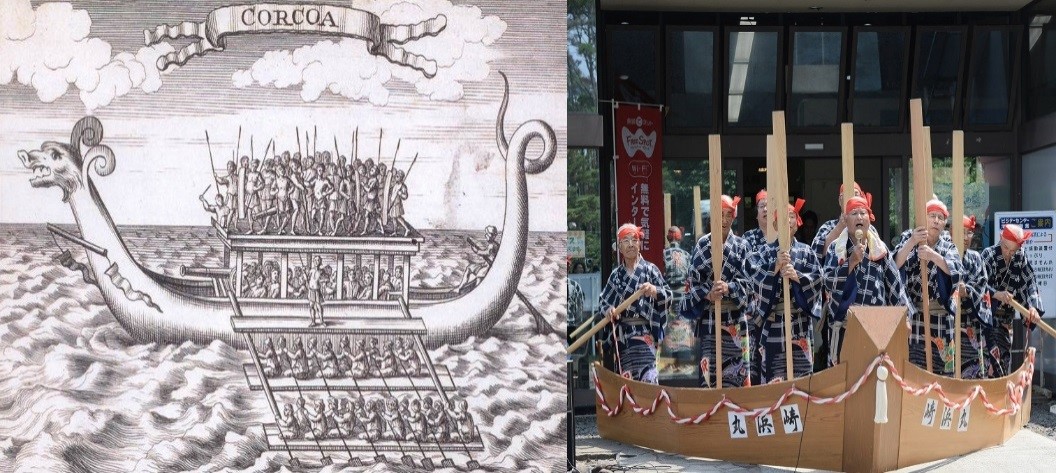In my maiden article for this column I made mentioned of a fishing village in Kesennuma, Miyagi prefecture, Japan. One of the villages we went to was Karakuwa. In the book, “Mindanao Muslim History: Documentary Sources from the Advent of Islam to the 1800s,” which I co-authored and published this year at the auspices of Ateneo de Davao University, Caracoa is repeatedly mentioned along with other indigenous warships which sorts of “challenged Western gunboats by sheer maneuverability and speed” in navigating the seas of Visayas and Mindanao (2017, 76). Caracoa or Karakuwa was a large boat, the fastest at the time and equivalent to the battleships in modern times. These ships were largely employed by Muslim polities (e.g. Sultanates of Maguindanao and Sulu).
What makes this encounter more interesting?

The photo above is caracoa (Corcoa) as depicted by Bartholomew Argensola (1708). The photo on the right was taken at Karakuwa Visitor and Tsunami Center in Kesennuma with their traditional fishermen’s performance (circa 2017).
Does it sound interesting? As a glocal scholar, I find meaning in my intellectual pursuits when such effort intersects with that of my humble beginning – a long history of working with the “seas.” Coastal communities do not only produce fisherfolks but also seafarers and coastguards; like my brothers and my dad to whom I owe a lot in this lifetime. The coast is lonely without the seaports, to which stevedores and laborers are born.
In the first part of this article, I spoke about the small entrepreneurs who ventured Davao in the early 1900s. Does the name Ohta Kyozaburo ring a bell? As the father of Japanese emigrants to Davao, Ohta was notable one of those considered as early pioneers and “builders” of Davao. The monumental obelisk erected in his name in Mintal, Davao City bears the inscription “To the Man Who Believed In Davao.” According to the many accounts of his noble quest, Ohta came to Davao a poor man but died a multimillionaire. It was in 1903 that Ohta first arrived in Luzon Island and later moved to Mindanao along with more than 300 Japanese laborers to help him in his new enterprise which was hemp (abaca) cultivation.
Indeed, this great man deserves all the respect but I also need to take off my hat to hundreds, if not thousands of laborers, both Japanese and Filipinos, who made this endeavor a possibility for Davao to prosper in the prewar era. The Japanese government obviously encouraged these emigrants and laborers to come to the Philippines to somewhat address labor problems back home especially for the Okinawans. Due to the booming industry, Davao became the center of economic activity even surpassing Zamboanga. In the 1930s, the busy streets of San Pedro and Anda were filled with Japanese enclaves along with small shops, boutiques, restaurants and bazaars. Of course, the hustles and bustles of the emerging economic center then did not come to fruition without an entry point – seaports.
As an American colony, the Philippines was subservient to the former – their economic and even political interests. Economically, the Philippines largely supplies the USA of their demand for hemp – a plant fiber extracted used to make ropes for their ships and fabrics for clothing. The political interests, however, intermeshed with conflicting local interests. Though in 1908 the Philippine Legislature declared the port of Davao opened to foreign trade, this was not without objections until it became an official policy in the 1920s. The presence of Japanese entrepreneurs, industrialists and businessmen like Furukawa Yoshizo did not go along with the local compradors and their cohorts, resulting in the so-called “Davao Problem,” which I will expound further in the succeeding articles.
Thus, it can be said that Davao as a port city began in the prewar era. In fact, aside from exports of raw products (i.e. rubber, copra, lumber and hemp fiber), Davao was also known as stopover port for Japanese annual tours to the South Seas Islands (Japan’s mandated islands in the South Pacific); whether official, semi-official or unofficial trips. For instance, in one occasion in the 1930s, students would leave from Tokyo via Kobe for a three-month tour of Taiwan, Manila, Davao, Palau and Saipan and then back to Yokohama.
Indeed, we could trace Davao’s progress back to its humble beginnings, settled by people of diverse backgrounds. Aside from Japanese and some Americans, Filipino settlers also came to Davao from the Visayas and Luzon Islands. But of course, this “intermingling process” or happenstance for that matter was not peaceful and without tensions. Hostile encounters between the settlers and the original inhabitants was fraught with bloody contest for survival and for their territorial and ancestral claims; everyone defended their own lot. Hence, it is a must that we do not overlook this segment of Davao history as it shapes our present circumstances – only then that we could be much wiser and more mindful of the future ahead. Certainly, just as the famous adage asserts, “…rough seas make good sailors.” (davaotoday.com)
To be continued
Andi, owing to the Japanese Romaji version of his Katakana nickname アンディ, is a loving husband to a wife, a teacher, researcher, political analyst, and a community development specialist. He finished his PhD in Japan and has travelled extensively around East and Southeast Asia.






